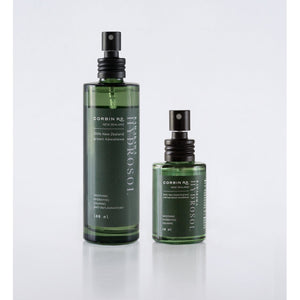
Why exfoliate?
Exfoliators play an important role in skincare by helping to buff away pollution, dirt and dead skin cells from the skin's surface, which in return helps to promote healthy cell turnover and glowing complexion. Exfoliators come in two forms chemical and physical and are generally designed to help even out textural irregularities, unclog dirt from pores, prevent breakouts and transform dull skin.
Physical or Chemical:
What Kind of Exfoliator is Best?
The contrast between chemical and physical exfoliants is all in the name, so neither are better than the other as long as they are safe, not overused and achieve the goal without damaging the acid mantle of your skin which protects your skins natural protective barrier.

Types of
physical exfoliation
Physical exfoliants use something physical, such as granular scrubs, cloths, brushes, sponges and an array of tools and gadgets. But not all are the same, some physical exfoliators are known to cause micro-tears that are created by grains, ground up nuts, salts or sugars that are too sharp or jagged, causing little micro tears in the skin. So it's important to ensure if you choose this form of exfoliator the particle size is fine and designed for the face. There are many great scrubs out there, this is just a word of caution, if it feels like it's scratching don't use it.
Types of chemical exfoliation
Chemical exfoliants remove dead skin cells with the use of acids (alpha-hydroxy acids/ AHAs or beta-hydroxy acids/ BHAs) to aid in skin cell turnover and remove dead skin cells by dissolving the "glue" that binds them to other dead skin cells, known as Lactic acid, Glycolic acid, Salicylic acid and more.

Can I use both,
physical and chemical exfoliant?
Chemical and physical exfoliants should not be used together ,at the same time or on the same day. You risk stripping your natural barrier and undoing all the good, more about that later. You can alternate days but, just keep in mind the stronger the exfoliant the less often you need to exfoliate.
So what does over-exfoliated skin look like?
- It will be red and inflamed
- it feel become sensitized and irritated to other products and
- often you will see tiny pimples and thick inflamed congested looking skin
If this happens, just stop! Stop using soap cleansers and active skincare such as Vit C or A and especially stop any exfoliators. Your skin could take up to a month to recover as that is the full skin cell cycle. Apply cold presses as often as possible to get the inflammation done, apply fresh aloe vera if possible and use balms or oils to cleanse, and a physical sunscreen.

The last word
Exfoliating regularly can soften the appearance of fine lines and make it easier for skin-care products that follow to absorb and penetrate deeper into the skin. Without incorporating exfoliators pores can remain clogged, giving the appearance of larger, more open pores and minimises the efficiency of skin care products to follow.
More words of caution
Exfoliating regularly can soften the appearance of fine lines and make it easier for skin-care products that follow to absorb and penetrate deeper into the skin. Without incorporating exfoliators pores can remain clogged, giving the appearance of larger, more open pores and minimises the efficiency of skin care products to follow. More words of caution.
A factor to consider when using chemical exfoliators like AHAs is the geographical location, in this instance, the Southern Hemisphere. The depletion of the ozone layer in this region has caused an increased exposure to ultraviolet (UV) radiation levels, UVA or UVB, from the sun to reach the Earth's surface. Some of the profound effects of a thinning ozone layer are its adverse impact on skin health such as skin cancers, irritation, sensitivities and premature skin ageing. With the skin already vulnerable to environmental stressors, AHAs can cause further damage to the skins protective barrier function if not properly used before a highly protective sunscreen.

Viteve™ Silk Exfoliating Cloth


